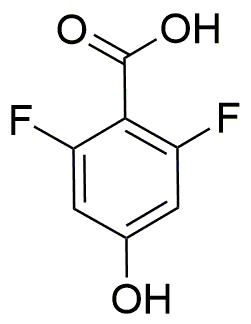2,6-Difluoro-4-hydroxybenzoic acid is widely utilized in research focused on:
- Pharmaceutical Development: This compound serves as an intermediate in the synthesis of various pharmaceuticals, particularly in the development of anti-inflammatory drugs. Its unique structure allows for enhanced efficacy and reduced side effects.
- Agricultural Chemicals: It is used in formulating herbicides and fungicides, providing effective solutions for crop protection. The difluoro substitution enhances its activity against specific pests, making it a valuable tool for farmers.
- Analytical Chemistry: The compound is employed as a standard in chromatography, aiding in the accurate analysis of complex mixtures. This application is crucial for laboratories ensuring the quality and safety of products.
- Material Science: It is incorporated into polymer formulations to improve thermal stability and chemical resistance. This application is beneficial in industries that require durable materials, such as automotive and electronics.
- Research in Environmental Science: The compound is studied for its potential impact on ecosystems, helping researchers understand its degradation pathways and environmental fate, which is essential for regulatory compliance and sustainability efforts.
General Information
Properties
Safety and Regulations
Applications
2,6-Difluoro-4-hydroxybenzoic acid is widely utilized in research focused on:
- Pharmaceutical Development: This compound serves as an intermediate in the synthesis of various pharmaceuticals, particularly in the development of anti-inflammatory drugs. Its unique structure allows for enhanced efficacy and reduced side effects.
- Agricultural Chemicals: It is used in formulating herbicides and fungicides, providing effective solutions for crop protection. The difluoro substitution enhances its activity against specific pests, making it a valuable tool for farmers.
- Analytical Chemistry: The compound is employed as a standard in chromatography, aiding in the accurate analysis of complex mixtures. This application is crucial for laboratories ensuring the quality and safety of products.
- Material Science: It is incorporated into polymer formulations to improve thermal stability and chemical resistance. This application is beneficial in industries that require durable materials, such as automotive and electronics.
- Research in Environmental Science: The compound is studied for its potential impact on ecosystems, helping researchers understand its degradation pathways and environmental fate, which is essential for regulatory compliance and sustainability efforts.
Documents
Safety Data Sheets (SDS)
The SDS provides comprehensive safety information on handling, storage, and disposal of the product.
Product Specification (PS)
The PS provides a comprehensive breakdown of the product’s properties, including chemical composition, physical state, purity, and storage requirements. It also details acceptable quality ranges and the product's intended applications.
Certificates of Analysis (COA)
Search for Certificates of Analysis (COA) by entering the products Lot Number. Lot and Batch Numbers can be found on a product’s label following the words ‘Lot’ or ‘Batch’.
*Catalog Number
*Lot Number
Certificates Of Origin (COO)
This COO confirms the country where the product was manufactured, and also details the materials and components used in it and whether it is derived from natural, synthetic, or other specific sources. This certificate may be required for customs, trade, and regulatory compliance.
*Catalog Number
*Lot Number
Safety Data Sheets (SDS)
The SDS provides comprehensive safety information on handling, storage, and disposal of the product.
DownloadProduct Specification (PS)
The PS provides a comprehensive breakdown of the product’s properties, including chemical composition, physical state, purity, and storage requirements. It also details acceptable quality ranges and the product's intended applications.
DownloadCertificates of Analysis (COA)
Search for Certificates of Analysis (COA) by entering the products Lot Number. Lot and Batch Numbers can be found on a product’s label following the words ‘Lot’ or ‘Batch’.
*Catalog Number
*Lot Number
Certificates Of Origin (COO)
This COO confirms the country where the product was manufactured, and also details the materials and components used in it and whether it is derived from natural, synthetic, or other specific sources. This certificate may be required for customs, trade, and regulatory compliance.


